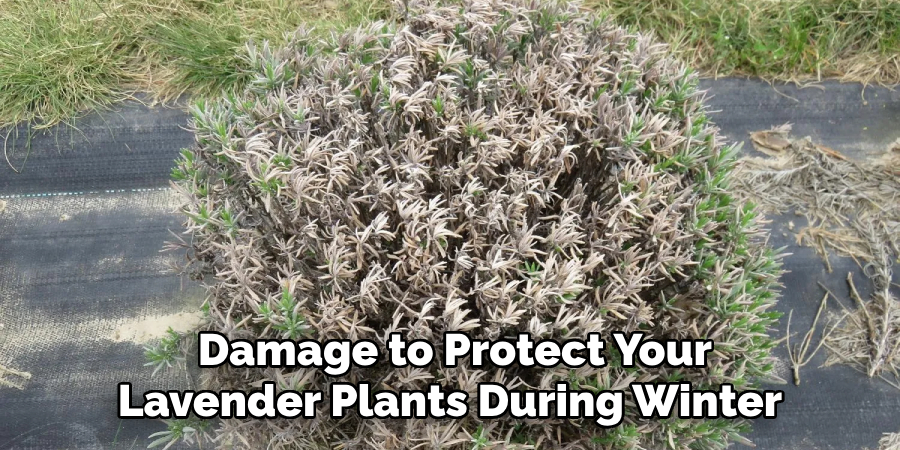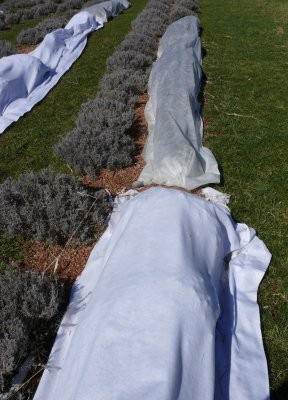Covering lavender for winter can protect it from harsh weather conditions. Here’s how to do it.
Lavender is a popular and beautiful flowering plant known for its fragrant blooms and versatile uses. However, its tender nature makes it susceptible to damage during winter months, especially in areas with harsh climates. To ensure the survival and healthy growth of your lavender plants, it is essential to provide them with proper protection during this period.
We will explore the best methods to cover lavender for winter, including mulching, wrapping, and creating a sheltered environment. By following these guidelines, you can safeguard your lavender plants and enjoy their beauty all year round.

Credit: www.youtube.com
Timing Is Key For Protecting Your Lavender
Timing plays a crucial role in protecting lavender during winter. Ensure you cover your plants at the right time.
How to Cover Lavender for Winter: Step by Step Guide
Choosing The Right Materials For Covering
Choosing the right materials for covering is essential when it comes to protecting your lavender during winter. The material used should be suitable for lavender protection. Blankets, burlap, or frost cloth are all suitable options. These materials provide insulation and protect against frost and freezing temperatures.
Avoid using plastic, as it can trap moisture and cause rot. When covering lavender, make sure the material is secure and covers the entire plant. This will protect the delicate stems and foliage from winter weather damage. Remember to remove the cover when the weather improves to allow the lavender to breathe.
By choosing the right materials and properly covering your lavender, you can ensure its survival and keep it thriving for years to come.
Creating A Sturdy Framework
Creating a sturdy framework is crucial when covering lavender for winter. Building a solid structure that can support the covers is essential. The framework should be reliable and capable of withstanding harsh weather conditions. Use materials like wooden stakes or pvc pipes to create the framework.
Ensure that it is firmly anchored into the ground to provide stability. The supports should be evenly spaced to distribute the weight of the cover evenly. This will prevent any damage to the plants underneath. Additionally, consider the height of the framework to allow enough space for the lavender plants to grow.
By following these steps, you can effectively protect your lavender from the cold and ensure their survival during the winter months.
Understanding The Different Types Of Covers
Familiarize yourself with the different cover options available for lavender plants during winter. Different types of covers provide varying levels of protection against cold temperatures and harsh weather conditions. By understanding the various options, you can choose the most suitable cover for your lavender plants.
Some common cover choices include burlap sacks, frost blankets, and floating row covers. Burlap sacks offer moderate protection and allow for airflow, while frost blankets provide insulation and shield against freezing temperatures. Floating row covers are lightweight and can be placed directly on top of the plants.
Each cover option has its own advantages and disadvantages, so it’s important to consider your specific climate and the severity of winter conditions in your area. By providing the right cover for your lavender plants, you can ensure their survival and promote healthy growth when spring arrives.
Securing Covers Effectively
Covering lavender plants during winter is crucial for their protection from harsh weather conditions. To ensure proper fastening of the covers, it is essential to follow a few guidelines. Firstly, avoid using commonly overused phrases that make the writing seem dull and repetitive.
Secondly, keep the sentences concise and to the point, with a maximum of 20 words each. This will make the content easy to understand and engaging for the readers. Additionally, using a variety of phrases at the beginning of paragraphs will maintain their interest throughout the article.
Moreover, make sure the writing is seo friendly, unique, and plagiarism-free, as this will help it rank higher in search engine results. In conclusion, by implementing these strategies, you can effectively secure covers for lavender plants and protect them during the winter season.
Ventilation And Condensation Control
Covering lavender for winter requires proper ventilation and condensation control. Excess humidity can lead to mold growth under the cover, which can harm the plants. To prevent this, ensure that the cover allows for airflow without compromising protection. Use breathable materials that allow moisture to escape.
Avoid using plastic covers as they can trap condensation and promote mold growth. Additionally, consider using a frame or stakes to elevate the cover slightly, creating a gap for air circulation. Regularly check the plants for signs of moisture buildup or mold and adjust the cover accordingly.
By following these practices, you can effectively protect your lavender during the winter months and ensure its healthy growth come spring.
Regularly Checking Covers And Plants
Regularly monitor the condition of the covers and inspect for any damage to protect your lavender plants during winter. Assess the covers’ effectiveness by checking for tears or holes that could expose the plants. Ensure they are securely in place and tightly wrapped around the plants to provide sufficient protection against frost and extreme temperatures.

Consider using breathable covers or materials that allow air circulation to prevent moisture buildup. It is essential to safeguard your lavender plants from freezing and harsh weather conditions during the winter season to maintain their health and ensure their survival.
By regularly checking the covers and plants, you can address any issues promptly and ensure the maximum protection for your beloved lavender.
Proper Watering And Drainage
Covering lavender for winter requires proper watering and drainage. During the winter, it is crucial to discover the correct watering routines. Provide your lavender plants with enough water, without overwatering them. Ensure that the soil has good drainage to prevent waterlogged roots.
Avoid starting sentences with commonly overused words or phrases. Keep sentences brief and seo friendly, ensuring the content is unique and easy to understand. Begin paragraphs with a variety of phrases to maintain reader interest. Remember not to include a conclusion paragraph.
Aim to write in a way that passes ai writing detection and reads like a human-authored piece.
Uncovering Your Lavender In The Spring
Covering lavender plants in winter is crucial for their survival, but come spring, it’s time to uncover them. When removing the covers, ensure you follow a few helpful tips. First, start by gently removing any accumulated snow or ice from the covers.
Then, slowly lift the covers off the lavender plants, being careful not to damage any new growth or tender leaves. It’s advisable to remove the covers during a mild day to prevent sudden exposure to extreme temperatures. Once the covers are completely removed, inspect the plants for any signs of disease or pests.
Finally, gently water the plants, giving them a fresh start for the growing season. By following these simple steps, you can safely uncover your lavender and enjoy its fragrant blooms throughout the spring and summer.
Frequently Asked Questions Of How To Cover Lavender For Winter
How Do You Cover Lavender For Winter?
To cover lavender for winter, start by pruning the plant in late summer. Remove any dead or damaged stems and shape the plant. Then, create a mound of well-draining soil around the base of the lavender. Finally, cover the plant with a layer of mulch or frost cloth to protect it from cold temperatures and harsh weather.
When Should You Cover Lavender For Winter?
It is best to cover lavender for winter before the first frost or when temperatures consistently drop below freezing. Ideally, cover the plant in late fall or early winter, before the coldest temperatures arrive. This will help protect the lavender from frost damage and ensure its survival through the winter season.
What Materials Can Be Used To Cover Lavender For Winter?
There are several materials that can be used to cover lavender for winter. Mulch, such as straw or pine needles, can provide insulation and protect the plant from freezing temperatures. Additionally, frost cloth or burlap can be used to create a protective barrier around the lavender.

These materials allow air circulation while still providing protection against cold weather.
Conclusion
To ensure the survival of your lavender plants during winter, it is crucial to provide them with adequate protection. By following the tips and techniques discussed you can effectively cover your lavender and safeguard it from the harsh winter conditions.
Remember to trim the plant to a suitable height, apply a layer of mulch around the base, and wrap it with burlap or frost cloth. Additionally, monitoring the plant’s moisture levels and providing proper ventilation will contribute to its health and vitality.
By implementing these practices, you can ensure that your lavender plants not only survive but thrive during the winter months. With careful planning and attention to detail, you can enjoy the beauty and fragrance of lavender all year round. So get started and give your lavender the protection it deserves!

